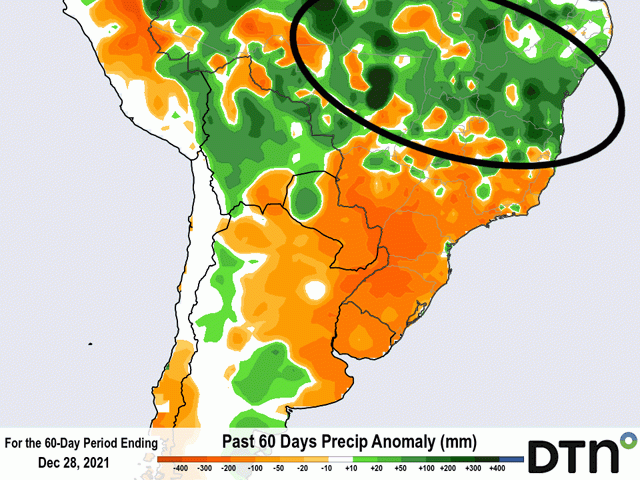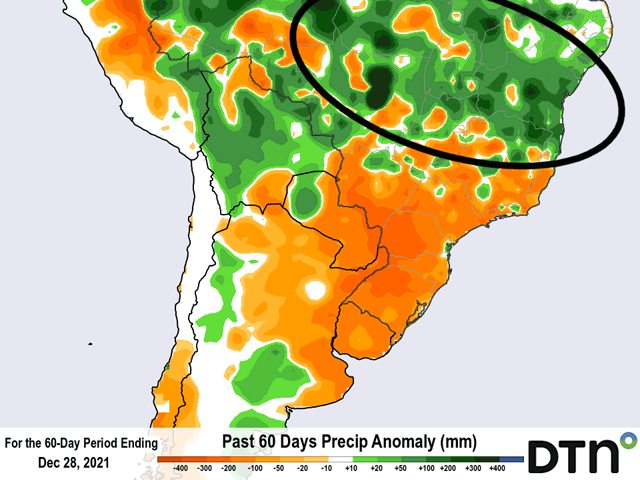South America Calling
Wetness a Concern for Northern Brazil
We have been focused on dryness and drought in Argentina and southern Brazil for a while now, with good reason. A La Nina event in the equatorial Pacific Ocean has led to dry conditions in that part of South America for some time and the lack of moisture is having an effect on crop production.
What we may have gotten lost in is the consistent heavy rains that have fallen across central and northern Brazil during the same time. Since the end of October, precipitation has largely been 100 to 300% above normal for the states of Mato Grosso, northern Goias, northern Minas Gerais, and most of Bahia and Tocantins.
That is a stark contrast from last year, being 200 to 400 millimeters (roughly 8 to 16 inches) more than the same period last year.
This area of the country accounts for more than half of the corn and soybean production and is a big reason why crop production estimates for soybeans have remained largely unchanged even in the face of drought across the southern states. The rains have been consistent and persistent since the wet season started at the end of September and early October.
P[L1] D[0x0] M[300x250] OOP[F] ADUNIT[] T[]
But there is such a thing as too much rainfall. Flooding has broken out in Bahia. Many municipalities are under a state of emergency. A couple of dams have been opened to reduce flooding stress in some areas. But that is putting the flooding into other, more agricultural areas.
The state of Bahia itself is not a large producer of corn and soybeans. The state accounts for about 5% of total corn and soybean production. But the wetness that extends from that region southward into the higher production areas of Mato Grosso, Goias, and Minas Gerais is a little more concerning.
While these states are not dealing with flooding directly, the inundation of water is leaving fields wet at a time when soybeans and first-crop corn are starting to mature, especially for early-planted soybeans. If wetness continues, and models suggest it will for the next couple of weeks at least, maturing crops may have increased disease pressure or could even sprout in the field before harvest. What looks like a good crop could get its top taken off.
The bigger concern is actually the safrinha, or second crop. Almost all corn, the safrinha crop accounts for about 75% of the corn production in Brazil. Brazilian farmers are able to double-crop soybeans with corn on a wide scale, but there is significant risk in doing so.
There is a defined wet and dry season in this area of the world. The wet season typically starts at the end of September and shuts down in early May. However, under La Nina conditions, the length of the wet season is typically reduced by a late start, and early end, or a mix of both. This season, the rains came on-time to start the season, but there is no guarantee that they will end on-time. If the rains shut down too early, then some of the crop could be caught in pollination and fill stages with only subsoil moisture to count on while temperatures rise up to 40 Celsius (100-105 Fahrenheit), a very stressful situation for corn.
Last year, rains ended about a month ahead of schedule, just after corn started emerging after late planting. When combined with some frosts during pollination and grain-fill, the results were disastrous. So, on-time planting is even more crucial under La Nina conditions. With the early planted soybeans, prospects were very favorable to get the soybeans out of the field and the corn into the ground in a timely fashion.
The continued rains have started to make some producers worry that they could be delayed in their soybean harvest. That couple push corn planting back a week or two as producers dodge showers and make the end of the wet season rains a bit more important.
Producers in central and northern Brazil are very used to the wetness, however. Again, it is the middle of the wet season, when daily showers pop up across the region, when producers are trying to harvest and plant in a typical year. Dodging rains are the name of the game. Usually, producers are successful at doing so, even if they are delayed a bit.
So, while the focus is still on the southern states of Brazil through Argentina for dryness, the wetness farther north may have at least some impact as well.
John Baranick can be reached at john.baranick@dtn.com
(c) Copyright 2021 DTN, LLC. All rights reserved.






Comments
To comment, please Log In or Join our Community .